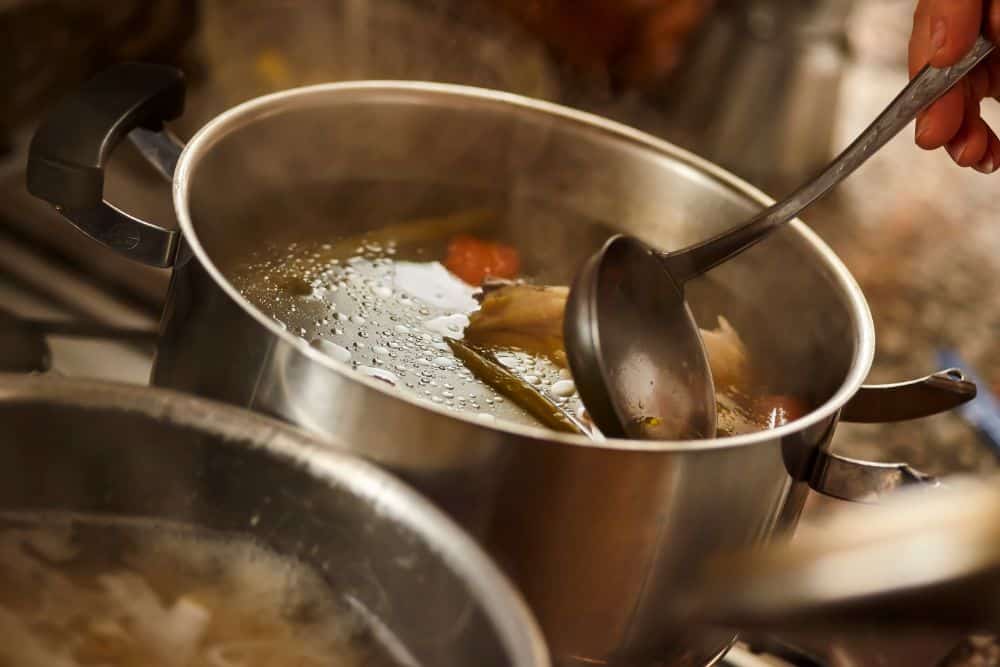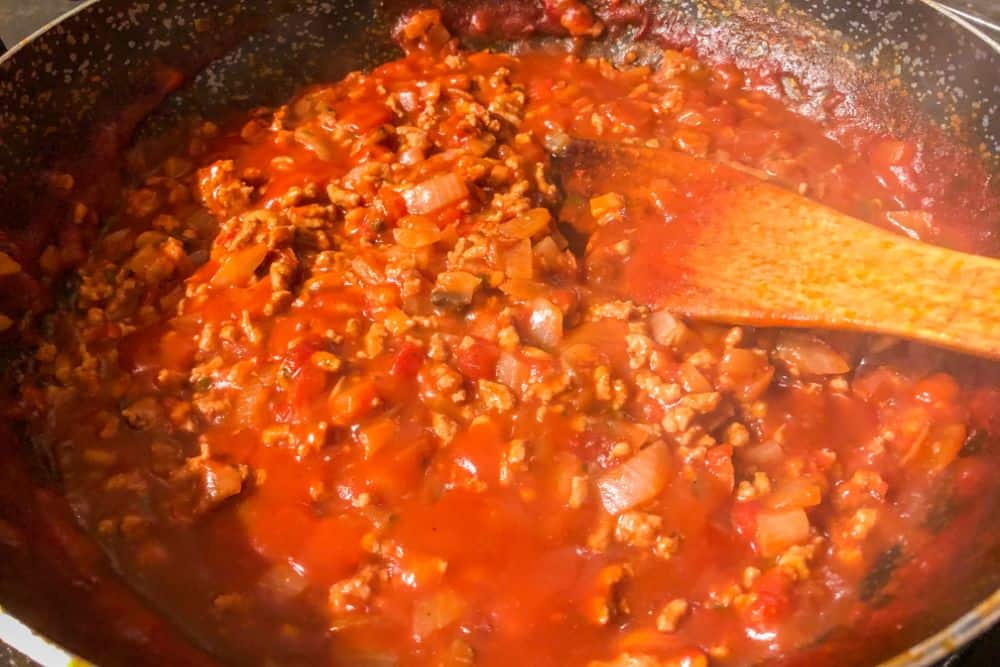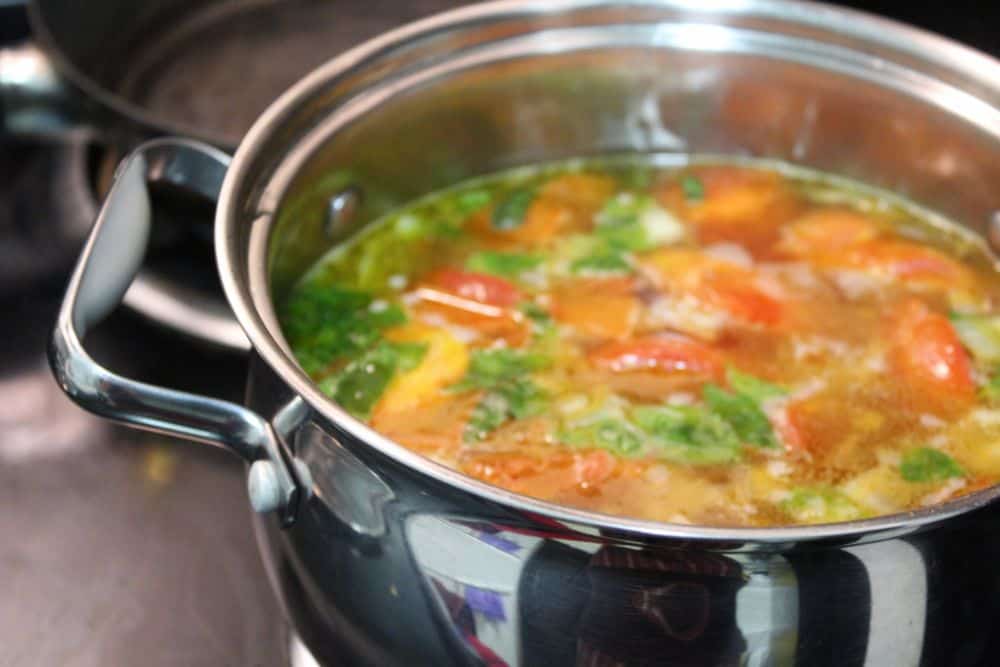Simmering food on the stove for 15 or 20 minutes is a staple cooking method. Soups, sauces, poaching, and many other cooking methods involve simmering. However, every dish defines a “simmer” differently or says to simmer with no further detail. This article will explain what simmering is, how to do it, and the best tools for the job.
Simmering is cooking food in water that is below the boiling point. At a rapid boil, bubbles rise constantly and aggressively from the bottom of the pot, whereas a simmer produces smaller bubbles and is gentler to the food as it cooks. The boiling point of water at sea level is 212 degrees Fahrenheit, you will simmer food between 185 and 205 degrees Fahrenheit.

A Soup Simmering Uncovered on the Stove
When a recipe calls for simmering, it does not always mean to put on the lid.
Since simmering uses a lower cooking temperature, the food usually cooks for a longer time compared to when it is subjected to an intense rolling boil. This means that spices, herbs, and other flavors are incorporated slowly for a deeper flavor. Certain foods even turn out better if cooked this way.
Simmer vs. Boil as Explained by Bed Bath & Beyond
Hardy vegetables, like carrots and potatoes, require more time to soften and take on flavor. Tomato sauces and soups will also appreciate more time for the flavors to meld together and natural sugars to concentrate. Poaching fish, eggs, or other delicate foods requires simmering because the bubbles from boiling can tear into the food.
In certain instances, a slow simmer is also appropriate when cooking meat. Tough cuts of meat with abundant connective tissue break down during the cooking process as they simmer. The process is similar to barbecuing, because low heat cooks the meat without toughening it.
Blanching vegetables requires a short exposure to a higher heat level. Vegetables, like peas or broccoli, should be placed in boiling water. Prolonged cooking time causes fresh vegetables to become mushy or gray. Pasta and grains also require boiling. In some cases, cooking grains like rice can include boiling, then simmering. Preparation will vary from food to food.
When adding a thickening agent, like a cornstarch slurry, boiling for a short period may be necessary to get the desired effect. Boiling also expedites the dissolution of curry, boullion, or other powdered additives.
Follow these steps to achieve and maintain a proper simmer.

Ground Beef Chili Simmering on the Stove
Keeping the lid on the pot traps heat and helps the liquid heat up more quickly. While effective for getting a liquid to the proper temperature, keeping the lid on actually interferes with maintaining a simmer. Trapping more heat can make the contents hotter than intended, causing them to boil.
When water boils, it is also evaporating, as both processes occur at the same temperature. It may seem counterintuitive to leave the lid off because it redirects steam back into the pot. However, when simmering, the water does not evaporate as frequently, and air circulates freely over the water’s surface. The airflow also prevents the water from reaching a boil because it offers temperature regulation.

The Lid Doesn’t Always Have to be on While Simmering
If the sauce or food begins splattering, then the temperature is probably too high. A simmer should be gentle, without large or violent bubbles, so a lid should not be necessary.
Sometimes, a recipe needs to simmer for one or several hours. Slow cooking dishes likely call for a low simmer, where there is little to no bubbling. Leaving the pot unattended without the lid might be a safety or sanitation concern. A covered pot can offer peace of mind. As long as the heat is low enough, the lid should not trap enough heat for the liquid to boil.
Some recipes do not specify whether or not the lid should be added during a simmer. In ambiguous situations, a few factors like moisture and desired thickness can determine whether the lid should be used.
When you’re simmering meat or grains, you want to make sure that the moisture is retained during cooking. The steam creates a tender result, with a gentle heat that penetrates the food.
When thickening a soup or sauce, leaving the lid off is necessary. As water evaporates, flavor concentrates, and the viscosity increases. This technique is also useful for gravy and stock.
Some types of pots and pans are more efficient for simmering than others. This section will address the factors that make a dish effective for simmering.
Pots with thick walls have more material to hold heat. That warmth from the heat source will travel more efficiently throughout the metal while staying in it longer. Because thick pots have more space between the heat source and the food, the heat distributes more evenly once it touches the food.
Thin pots take on heat more easily, but the distribution is uneven. They are more sensitive to changes from the heat source, so any slight adjustments can cause the liquid to boil or stop simmering altogether. Pots with thin bottoms are susceptible to warping, as well.
The metal or coating on a pot is almost more important than the thickness. They come in single materials or a combination of several for efficient heat distribution. Aluminum, iron, and copper are efficient conductors. Iron is the best for retaining heat.
Aluminum and copper are sometimes added to the bottoms of pans to aid in heat distribution. Cast iron pans require special upkeep, but an enamel coating can eliminate this problem.
Some foods also have acidic properties that react to metals, like tomato sauce, fruit, and wine. Cooking these in the wrong metals can affect the flavor and appearance of the result. Since these are everyday ingredients in soups and sauces, pots with non-reactive materials are a worthwhile investment.
The George Forman Indoor/Outdoor Electric Grill
Copper and aluminum are highly effective at conducting heat, but are also highly reactive to acidic foods. Some pots only utilize aluminum and copper on the bottom, where they serve as heating elements. These offer a compromise for pots made from metals that heat up slowly, like iron. Iron is already non-reactive, but an enamel coating allows for easier maintenance.
Other options include stainless steel and anodized aluminum. Stainless steel is naturally non-reactive but a poor conductor. Anodized aluminum has an electrochemical seal that protects food from the metal.
Many simmered dishes can cook for an hour or more to develop the flavor. For example, making broth or stock involves stewing bones and vegetables for a very long time. Some professional restaurants even simmer their stocks for an entire day! A sturdy pot is ideal for dishes that require prolonged cooking.
Calphalon and iron cookware are highly effective at retaining heat. This is extremely important for dishes that require unsupervised simmering because a good pot will require less heat adjustment.
Lids aren’t necessarily used when simmering. It depends on what your recipe calls for. By keeping the lid on, you may inadvertently raise the temperature from a simmer to a boil For recipes that require long duration cooking in a slow cooker, you may be able to achieve a steady simmer with the lid on at lower temperatures (like medium-low to low).
If your recipe calls for a “rapid simmer”, you’ll want to have the temperature below that of a rolling boil. A rapid simmer should have smaller tiny bubbles that aren’t necessarily consistently breaking surface - this differs greatly from the large, constant bubbles that are characteristic of a boiling liquid. If your dish is boiling when it should be simmering, take the lid off and lower your temperature to bring it back to a simmer.
Nope. While "low heat" is a subjective term, cooking liquid at a simmering temperature means cooking between 185 degrees and 205 degrees Fahrenheit. This isn’t considered to be a low temperature as it isn’t too far away from the 212 degree Fahrenheit boiling temperature of water.
While a temperature setting for simmering shouldn’t produce a rolling boil, it may be hot enough to produce small bubbles in your dish that will break the surface.
